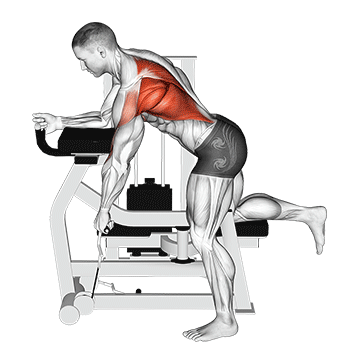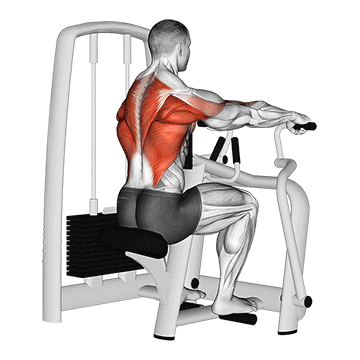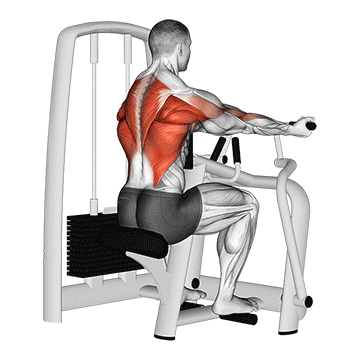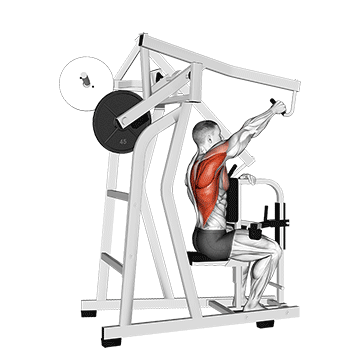Training your upper back is a vital part of building and shaping your back. Whether you are a gym rat or devising your first training plan, the workouts below will help you meet your fitness goals.
lever unilateral row

1. Start by adjusting the lever machine to your height. The handle should be at chest level when you're standing upright.
2. Stand sideways to the machine, placing your feet shoulder-width apart for stability.
3. Grab the handle of the lever machine with the hand that's closest to it. Your palm should be facing down.
4. Bend your knees slightly and lean forward from your hips, keeping your back straight. Your torso should be almost parallel to the floor.
5. Extend your arm fully, allowing the weight to pull it forward. This is your starting position.
6. Pull the handle towards your body, keeping your elbow close to your side. Your hand should come up to your chest, and you should feel a squeeze in your upper back muscles.
7. Hold this position for a second, then slowly return to the starting position.
8. Repeat this movement for your desired number of repetitions.
9. Once you've completed your set, switch to the other side and repeat the exercise with your other arm.
Remember to keep your core engaged and your back straight throughout the exercise. Avoid using your body momentum to pull the weight, instead focus on using your upper back muscles.
lever t-bar reverse grip row
1. Start by positioning yourself on the leverage machine. Stand facing the machine with your feet shoulder-width apart.
2. Grab the lever with a reverse grip, meaning your palms should be facing upwards. Ensure your hands are slightly wider than shoulder-width apart.
3. Bend your knees slightly and lean forward from your waist. Keep your back straight and almost parallel to the floor. This is your starting position.
4. Pull the lever towards your upper abdomen while keeping your elbows close to your body. As you pull, squeeze your shoulder blades together and keep your upper body still.
5. Hold this position for a second to maximize the contraction in your upper back muscles.
6. Slowly return the lever to the starting position, allowing your arms to fully extend and your shoulder blades to stretch apart.
7. Repeat this movement for the desired number of repetitions.
Remember to keep your core engaged throughout the exercise to maintain balance and stability. Also, ensure that the movement is controlled and steady, focusing on the muscle contraction and not on the weights.
lever t bar row
1. Start by loading the appropriate weight onto the lever t-bar row machine.
2. Stand on the platform of the machine, facing the bar. Position your feet shoulder-width apart for stability.
3. Bend your knees slightly and lean forward from your waist. Ensure your back is straight and almost parallel to the floor.
4. Grasp the handles of the bar with both hands. Your palms should be facing each other. This is your starting position.
5. Pull the bar towards your upper waist by retracting your shoulder blades and flexing the elbows. Keep your elbows close to your body throughout the movement.
6. Squeeze your back muscles at the top of the movement for a second to ensure maximum muscle engagement.
7. Slowly lower the bar back to the starting position, extending your arms fully and allowing your shoulder blades to spread apart.
8. Repeat the movement for the desired number of repetitions.
Remember to keep your back straight and avoid any jerky movements to prevent injury. The movement should be controlled and smooth, focusing on the muscle contraction and relaxation.
lever seated row

1. Start by adjusting the seat on the leverage machine to a height where your chest is level with the handles.
2. Sit down on the machine and place your feet on the provided footrests. Make sure your knees are slightly bent and not locked.
3. Reach forward to grab the handles. Your palms should be facing each other. This is your starting position.
4. Pull the handles towards your torso while keeping your back straight and your chest up. Your elbows should be close to your body as you pull.
5. Squeeze your shoulder blades together at the end of the movement, holding for a second to maximize the contraction in your upper back.
6. Slowly return the handles back to the starting position. This should be a controlled movement, don't let the weight stack drop.
7. Repeat for the desired number of repetitions.
Remember to keep your spine neutral and avoid using your momentum to pull the handles. The movement should be driven by the muscles in your upper back and arms.
lever reverse t-bar row
1. Start by positioning yourself on the leverage machine. Stand facing the machine with your feet shoulder-width apart.
2. Bend your knees slightly and lean forward from your waist. Ensure your back is straight and almost parallel to the floor.
3. Grab the handles of the machine with both hands. Your palms should be facing each other. This is your starting position.
4. Pull the handles towards your upper abdomen while keeping your elbows close to your body. Ensure you squeeze your shoulder blades together when you reach the peak of the movement.
5. Hold this position for a second, then slowly lower the handles back to the starting position.
6. Repeat this movement for the desired number of repetitions.
Remember to keep your back straight and avoid any jerky movements to prevent injury. The movement should be controlled, focusing on the contraction and extension of the upper back muscles.
lever reverse grip vertical row

1. Start by setting the appropriate weight on the leverage machine. Make sure it's a weight you can handle without straining your muscles too much.
2. Stand in front of the machine with your feet shoulder-width apart. Make sure your body is aligned with the machine's lever.
3. Reach up and grab the lever with a reverse grip, meaning your palms should be facing you. Your hands should be slightly wider than shoulder-width apart.
4. Pull the lever down towards your chest while keeping your elbows close to your body. Ensure your back is straight and your core is engaged throughout the movement.
5. Pause for a moment when the lever reaches your chest, squeezing your shoulder blades together to engage your upper back muscles.
6. Slowly release the lever back to the starting position, ensuring you maintain control of the movement. This should not be a quick release, but a slow and controlled movement.
7. Repeat this exercise for the desired number of repetitions.
Remember to keep your body stable throughout the exercise, avoiding any swinging or jerking movements. This will ensure you're targeting the correct muscles and not risking injury.
lever one arm lateral high row

To perform the Lever One Arm Lateral High Row, follow these steps:
1. Start by adjusting the lever machine to your height and select the weight you're comfortable with.
2. Stand sideways to the machine, placing your feet shoulder-width apart for stability.
3. Reach out and grab the lever handle with the hand that's closest to the machine. Your arm should be fully extended.
4. Keep your back straight, engage your core, and slightly bend your knees.
5. Pull the lever towards your body, keeping your elbow high and in line with your shoulder. Your hand should come up to about chest level. Make sure to squeeze your shoulder blades together at the top of the movement.
6. Slowly return the lever to the starting position, allowing your arm to fully extend. This completes one rep.
7. Perform your desired number of reps on one side, then switch to the other side.
Remember to keep your movements controlled and steady, focusing on the muscle contraction and relaxation. Avoid using your body momentum to pull the lever, as this can lead to injury and won't effectively target your upper back muscles.
lever narrow grip seated row
1. Start by adjusting the seat on the leverage machine to a height that allows your feet to be flat on the floor and your knees to have a slight bend.
2. Position yourself on the seat and grasp the handles of the machine with a narrow grip. Your palms should be facing each other.
3. Sit upright with your back straight and your chest out. This is your starting position.
4. Pull the handles towards your torso while keeping your elbows close to your body. As you pull, squeeze your shoulder blades together.
5. Hold this position for a moment, ensuring you feel the contraction in your upper back muscles.
6. Slowly return the handles to the starting position, allowing your arms to fully extend and your shoulder blades to spread apart.
7. Repeat this movement for the desired number of repetitions.
Remember to keep your back straight and avoid using your body momentum to pull the handles. The movement should be controlled and focused on the upper back muscles.
lever high row
To perform the Lever High Row, follow these steps:
1. Start by adjusting the seat of the leverage machine to a height that allows your chest to be in line with the machine's handles when seated.
2. Sit down on the machine and place your feet firmly on the ground. Your knees should be bent at a 90-degree angle.
3. Reach forward and grasp the handles of the machine. Your palms should be facing each other and your hands should be wider than shoulder-width apart.
4. Pull the handles towards your upper chest while keeping your elbows out to the sides. This is your starting position.
5. Exhale as you pull the handles towards your body. Keep your back straight and squeeze your shoulder blades together at the top of the movement.
6. Hold this position for a second to maximize the contraction in your upper back muscles.
7. Slowly return the handles to the starting position while inhaling.
8. Repeat this movement for the desired number of repetitions.
Remember to keep your back straight and avoid using your body momentum to pull the handles. The movement should be controlled and focused on the upper back muscles.
lever bent-over row with v-bar
1. Start by adjusting the lever machine to your height. The v-bar should be at about waist level when you're standing upright.
2. Stand facing the lever machine with your feet shoulder-width apart. Bend your knees slightly and lean forward from your hips, keeping your back straight. Your torso should be almost parallel to the floor.
3. Grab the v-bar with both hands. Your palms should be facing each other. This is your starting position.
4. Pull the v-bar towards your abdomen while keeping your elbows close to your body. Squeeze your shoulder blades together as you perform this movement.
5. Hold the contraction for a second at the top of the movement, then slowly lower the v-bar back to the starting position.
6. Repeat for the desired number of repetitions.
Remember to keep your back straight and your core engaged throughout the exercise. Avoid using your lower back or momentum to pull the v-bar. The movement should be controlled and focused on your upper back muscles.
lever alternating narrow grip seated row
1. Start by adjusting the seat on the leverage machine to a height that allows your feet to be flat on the floor and your knees slightly bent.
2. Sit down on the machine and grasp the handles with a narrow grip. Your palms should be facing each other.
3. Pull the handles towards your torso while keeping your back straight and your chest up. This is your starting position.
4. Exhale as you pull the handles towards your body, squeezing your shoulder blades together. Your elbows should be close to your body and you should feel a contraction in your upper back muscles.
5. Hold this position for a moment, then slowly return the handles to the starting position while inhaling.
6. Repeat this movement, alternating between pulling with your right and left arm.
7. Continue for the desired number of repetitions.
Remember to keep your core engaged throughout the exercise to protect your lower back. Also, avoid using your biceps or forearms to pull the weight; the focus should be on your upper back muscles.
No tags for this post.
